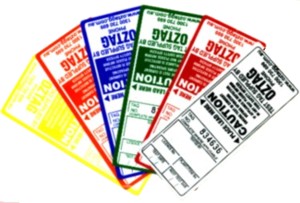
While many people conduct their testing and tagging in house, the majority of organisations choose to outsource their electrical safety management programs to a specialist provider. This comes with many benefits, especially considering an external provider typically completes testing more quickly, and in many cases a more comprehensive service is provided.
But like any industry, there are reputable and not so reputable test and tag providers.
Some providers are large, national organisations and some are small, one-man operations; some are franchised and some directly employ the technicians providing the service. There is no one right choice for every organisation, but regardless of your decision there are 10 key questions you should ask before one item is tested.
1. Can I see your test and tag qualification?
All test and tag technicians should have completed a course in testing and tagging. This basic, one day course gives technicians an understanding of the way electrical appliances operate and qualifies them to test these appliances using a portable appliance tester (PAT).
The PAT completes the tests for the technician so a broader understanding of electrical circuitry as taught during an electrical apprenticeship is not required.
Note that in Queensland all testing and tagging organisations are additionally required to hold a QLD Electrical Contractor’s licence, and you should request a copy of this licence.
2. How long have you been testing and tagging?
Ask anyone who has completed a one day course whether they know everything possible about the subject they have just studied and the answer will be a resounding ‘no’. Testing and tagging is no exception.
The number and diversity of appliances, environments and faults encountered by technicians simply cannot be taught in one day! It takes years for any tradesman to learn his craft – learning that comes through experience and education – and from experience we understand that it takes at least six months of full time testing for technicians to become comfortable with testing protocols, sometimes longer!
3. What equipment do you use when testing and tagging?
There is an incredibly wide range of test equipment on the market, and there are some obvious benefits to some equipment and some not-so-obvious pitfalls to other equipment.
Firstly, you need to determine how you want to see your results. Are you happy with a handwritten log of testing showing Pass and Fail, or would you prefer an electronic printed register with audited test history of each individual test conducted? If you are happy with a handwritten log detailing Pass or Fail, then you might also be happy with handwritten test tags on your appliances, and therefore you can choose a provider that operates basic hand held test equipment or your local electrician operating equipment.
But if you want an electronic register with fully traceable test results, then you will need to choose a provider operating test equipment that stores the test results. A provider using equipment that stores the test results will also be able to provide you with a detailed summary of the individual tests conducted on your appliances. In this way you can form an electrical history of your appliances, and not simply a register of Pass or Fail.
4. How do I get my results?
If you have chosen a supplier using handheld test equipment, then your handwritten registers should be provided to you on the day of testing as a pass or fail is simply noted on the report. Asset IDs may or may not be added to the tag and the register, and will depend on the service provider.
At the other end of the scale, electronic test reports are prepared off site once the test data file has been processed and ideally independently audited by someone other than the testing technician. These reports contain individual asset IDs for each site along with an asset description for easy identification.
The reports will be printed or emailed to you, and some service providers may make them available on the internet for you to download as required. A reputable provider should be able to have your reports to you within days of the conclusion of testing.
5. Will I get a Certificate of Compliance?
A Certificate of Compliance will state that at the time of testing, all appliances made available on site were tested by the attending technician.
Time and date stamped test results are therefore vital in the event of an incident as it can be accurately determined when and where the appliance was tested, the individual test results and the name of the technician who tested.
6. Can you repair any of my appliances?
In all States, excluding Queensland, your technician will be able to repair or replace the plug or socket of your appliance while on site. This will ensure that following testing, your workplace is up and running quickly, which will reduce the risk of your staff using failed items in an unsafe workplace.
7. Can I check the quality of your tags?
It is always a good idea to look at the tags your provider uses as not all tags are equal! Are they heat sensitive tags that could fade in direct sunlight or go black when positioned next to an urn? Can you read the retest date on a handwritten tag? Do the tags comply with the new Australian Standard? Are the tags individually printed on site with a unique asset ID?
The type of tag you choose should be determined by the type and the location of appliances in your business and as they stay with the appliance for up to five years, it is important to select the right tag for the job!
8. Will you charge a unit rate, an hourly rate, or a combination?
Does your service provider insist on an hourly rate, or even an hourly rate plus a unit test rate? Or do they charge one rate for the first few tests, another rate for subsequent tests? Or is it just a flat unit test rate?
Most quoted rates will include a component for the time it will take your service provider to process your data and prepare your reports, but again I would recommend confirming this before testing commences.
9. Do you have a copy of AS/NZS 3760:2010?
The revised Australian Standard for testing and tagging was released late 2010 and by now all technicians should own a current copy of the Standard and be fully conversant on the testing methods, and most importantly the revised retesting frequencies.
All reputable providers will be able to provide you with a copy of Table 4 from the Standard which details the recommended retesting time frames so that you can educate yourself on your obligations.
10. Can I have a copy of your Safe Work Method Statements and Insurance certificates?
Like any activity, there are safe ways to complete testing, and unsafe ways to complete testing. A reputable provider will be able to provide you with comprehensive Safe Work Method Statements (SWMS) not only for testing and tagging of your appliances, but also for RCD testing. If your provider doesn’t have their SWMS prepared, maybe you should be seeking an alternative provider.
Further, appropriate insurances are essential to any business. A test and tag provider should maintain WorkCover insurance (where applicable as directed by State legislation), Vehicle Insurance, Equipment insurance, Public Liability, and most importantly Professional Indemnity insurance.
We certainly recommend you contact your insurance adviser to confirm what insurances your service provider should have before they begin testing, and ask for Certificates of Currency in advance.
If you would like any further information, contact Sarah on 1300 287 669, by emailing sarah@atservices.com.au or visiting www.appliancetaggingservices.com.au.





